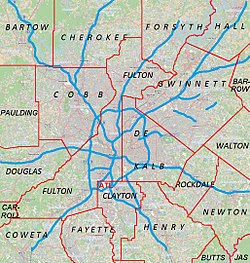South Forsyth Middle School
| Cumming, Georgia | |
|---|---|
| City | |

Cumming City Hall
|
|
| Motto(s): Gateway to Leisure Living | |
 Location in Forsyth County and the state of Georgia |
|
|
Location of Cumming in Metro Atlanta
|
|
| Coordinates: 34°12′30″N 84°8′15″W / 34.20833°N 84.13750°WCoordinates: 34°12′30″N 84°8′15″W / 34.20833°N 84.13750°W | |
| Country | United States |
| State | Georgia |
| County | Forsyth |
| Incorporated | 1834 |
| Chartered | 1845 |
| Named for | William Cumming |
| Government | |
| • Mayor | Troy Brumbalow |
| Area | |
| • Total | 6.1 sq mi (15.9 km2) |
| • Land | 6.1 sq mi (15.8 km2) |
| • Water | 0.04 sq mi (0.1 km2) |
| Elevation | 1,217 ft (371 m) |
| Population (2010) | |
| • Total | 5,430 |
| • Estimate (2016) | 6,225 |
| • Density | 891/sq mi (344.2/km2) |
| Time zone | Eastern (EST) (UTC-5) |
| • Summer (DST) | EDT (UTC-4) |
| ZIP codes | 30028, 30040, 30041 |
| Area code(s) | 770 |
| FIPS code | 13-20932 |
| GNIS feature ID | 0331494 |
| Website | www |
Cumming is a city in Forsyth County, Georgia, United States, and the sole incorporated area in the county. It is part of the Atlanta metropolitan area. Its population was 5,430 at the 2010 census, up from 4,220 in 2000. Surrounding unincorporated areas with a Cumming mailing address have a population of approximately 100,000. Cumming is the county seat of Forsyth County.
The area now called Cumming is located west of the historic location of Vann's Ferry between Forsyth County and Hall County.
The area, now called Cumming, was first inhabited by Cherokee tribes. They came in 1755. The Cherokee and Creek people developed disputes over hunting land. After two years of fighting, the Cherokee won the land in the Battle of Taliwa. The Creek people were forced to move south of the Chattahoochee River.
The Cherokee coexisted with white settlers until the discovery of gold in Georgia in 1828. Settlers that moved to the area to mine for gold pushed for the removal of the Cherokee. In 1835, the Treaty of New Echota was signed. The treaty stated that the Cherokee Nation must move to the Indian Territory, west of the Mississippi River. This resulted in the Trail of Tears. The Cherokee territory was then formed into Cherokee County in 1831. In 1832, the county was split into several counties including Forsyth County.
...
Wikipedia



